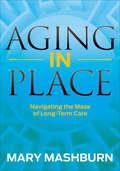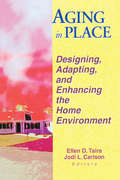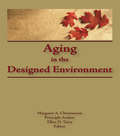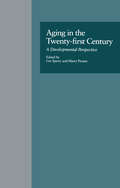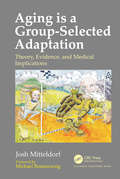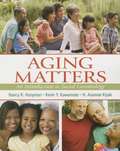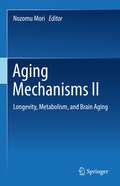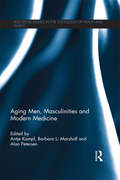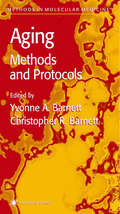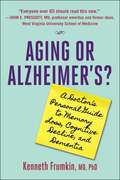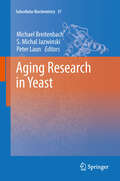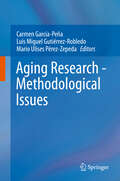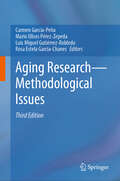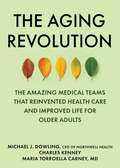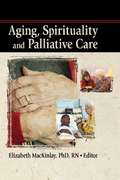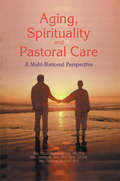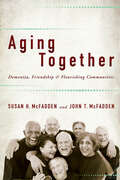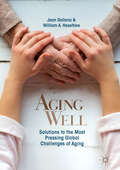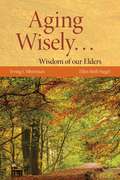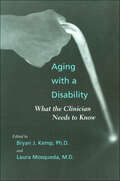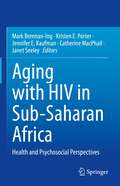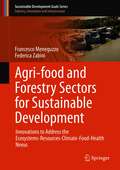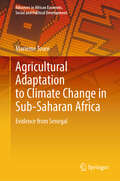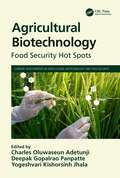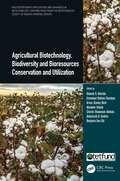- Table View
- List View
Aging in Place: Navigating the Maze of Long-Term Care
by Mary MashburnAn elder care expert offers essential information and advice on how to give your aging parent or loved one the best care possible in this stage of life. Caring for an aging parent or loved one can be overwhelming. From making sure their estate is in order and knowing their wishes are being honored, to more immediate concerns like where they will receive the best care after a hospital stay—there are many questions that are difficult to answer. In Aging in Place, certified senior advisor Mary Mashburn guides you through these and other common concerns so that you can address them with confidence and compassion. Using real life examples, Aging in Place promotes healthy family discourse on important elder care topics. Mary discusses the roadblocks and pitfalls you and your family might encounter, explains many useful planning techniques, and provides information on local and national resources. Whether in the midst of a crisis or just beginning to discuss options with loved ones, Aging in Place offers valuable insight and information on making choices that fit your unique situation.
Aging in Place: Designing, Adapting, and Enhancing the Home Environment
by Ellen D Taira Jodi CarlsonProvide a comfortable living environment for the aging!Aging in Place: Designing, Adapting, and Enhancing the Home Environment gives you a complete examination of current trends in adaptive home designs for older adults. As a therapist, designer, architect, builder, home planner, social worker, community organizer, or gerontologist, Aging in Place will show you innovative home designs and studies for creating environments that offer optimal living for aging adults. Complete with diagrams, floor plans, and tables, Aging in Place helps you to improve the quality of life for the elderly by offering them state-of-the-art designs that encourage independence and dignity. This unique and exciting book covers topics such as universal design which strives to create everyday environments and products like door handles and light switches that are usable by all people to the greatest extent possible, regardless of age or ability. Aging in Place will also show you how to: use follow-up visits by occupational therapists to ensure successful use of home modifications create environments that are helpful for vision rehabilitation by using controlled lighting and color schemes evaluate the quality of life for elderly people living in personal dwellings, specialized housing, and nursing homes explore architectural barriers and the uses of helping devices for elderly people examine research critiques of adaptive toilet equipment investigate modifications that have been made in homes for the elderly in India analyze ways in which elderly people have changed their homes to make the telephone more accessibleAging in Place is a complete guide to understanding the needs and latest trends in optimizing the living space of elderly persons. The book gives you access to several studies on elderly people's environmental needs and preferences in regard to modifications in personal and public dwellings. This information will assist you with better serving the elderly by helping them live more independently.
Aging in the Designed Environment
by Ellen D Taira Margaret ChristensonAging in the Designed Environment is the key sourcebook for physical and occupational therapists developing and implementing environmental designs for the aging. The physical environment remains one of the most overlooked areas in environmental design. In order to move beyond this status quo, persons responsible for planning elderly environments must develop a new understanding of ways in which their influence can improve the older adult’s physical and mental functioning. Occupational and physical therapists, as well as other health care professionals, will benefit tremendously from the information presented in this unique volume. Designers, developers, and others with minimal health care background will also find a wealth of possibilities within Aging in the Designed Environment. Many concerns are dealt with in the book’s five sections. The first section describes the implications that occur when there are changes in vision, hearing, taste, smell, touch, and the kinesthetic systems. Recommendations for environmental adaptation and modifications which may compensate for the changes in each of these systems are suggested. The second section stresses the relationship between behavior and environment. A variety of environmental attributes--comfort, privacy, accessibility, control, security, dignity--and their impacts are discussed, along with information on ways that attributes can be incorporated into the living settings of older people. In section three the focus is on the older person living independently in his or her own home, and section four covers exclusively the design and selection of chairs for older adults. New ways to assess and evaluate the home to promote independence beyond the traditional activities of daily living are addressed. The last section deals with redesigning the existing long-term care facility. The author examines some of the environmental conditions existing in specific facilities and provides recommendations to compensate for these circumstances.
Aging in the Twenty-first Century: A Developmental Perspective (Issues in Aging)
by Len Sperry Harry ProsenCovering a wide range of topics, this collection of original essays deals with the consequences and challenges of our growing aging population on society. It emphasizes aging as a developmental process while addressing the future of the practice of geropsychiatry and geriatric psychotherapy. This book serves as a valuable resource to guide clinical training, practice, and research on aging into the next century and beyond.
Aging is a Group-Selected Adaptation: Theory, Evidence, and Medical Implications
by Joshua MitteldorfAlthough books exist on the evolution of aging, this is the first book written from the perspective of again as an adaptive program. It offers an insight into the implications of research on aging genetics, The author proposes the Demographic Theory of Senescence, whereby aging has been affirmatively selected because it levels the death rate over time helping stabilize population dynamics and prevent extinctions.
Aging Matters: An Introduction to Social Gerontology
by Nancy R. Hooyman H. Asuman Kiyak Kevin Y. KawamotoPresents Social Gerontology from Multiple Perspectives Aging Matters illuminates cultural, biological, physiological, emotional, cognitive, economic, and social aspects of aging. A useful guide to a range of disciplines, this title helps readers of all educational backgrounds understand the dynamic interactions between older people and their environments.
Aging Mechanisms II: Longevity, Metabolism, and Brain Aging
by Nozomu MoriThis book describes the recent advancement of basic research on the biology of aging and longevity studies in various organisms, as well as the neurobiology of aging and neurodegeneration mechanisms. Chapters present new findings and conceptual developments concerning the basic mechanisms of aging and longevity determination. As a follow-up volume to the previous book Aging Mechanisms (2015), it overviews the rapid progress of aging research introducing new topics from leading laboratories in Japan. Chapter contributors are selected based on recent scientific achievements on the mechanisms of aging in various model organisms, including yeast, worm (C. elegans), fly (Drosophila), mice, and rats. Chapters are ordered from the discussion on molecular and cellular levels to physiological and systemic levels. The book also provides an overview of aging science in the region and helps readers quickly grasp who is doing what in this research area. As the aging of population becomes an ever more pressing issue in Asia, advancing the understanding of basic mechanisms of organism aging and longevity determination will be crucial to developing more effective therapies and protective strategies. Researchers and graduate students in biomedical aging research will find this as a rich source of information and a stimulus to novel research directions.
Aging Men, Masculinities and Modern Medicine
by Alan Petersen Antje Kampf Barbara L. MarshallAging Men, Masculinities and Modern Medicine explores the multiple socio-historical contexts surrounding men’s aging bodies in modern medicine from a global perspective. The first of its kind, it investigates the interrelated aspects of aging, masculinities and biomedicine, allowing for a timely reconsideration of the conceptualisation of aging men within the recent explosion of social science studies on men’s health and biotechnologies including anti-aging perspectives. This book discusses both healthy and diseased states of aging men in medical practices, bringing together theoretical and empirical conceptualisations. Divided into four parts it covers: Historical epistemology of aging, bodies and masculinity and the way in which the social sciences have theorised the aging body and gender. Material practices and processes by which biotechnology, medical assemblages and men’s aging bodies relate to concepts of health and illness. Aging experience and its impact upon male sexuality and identity. The importance of men’s roles and identities in care-giving situations and medical practices. Highlighting how aging men’s bodies serve as trajectories for understanding wider issues of masculinity, and the way in which men’s social status and men’s roles are made in medical cultures, this innovative volume offers a multidisciplinary dialogue between sociology of health and illness, anthropology of the body and gender studies.
Aging Methods and Protocols (Methods in Molecular Medicine #38)
by Yvonne A. Barnett Christopher R. BarnettYvonne and Christopher Barnett and a team of recognized international experts detail key biochemical, analytical, and molecular techniques for the investigation of aging at the cellular, tissue, organ, and whole system levels. These cutting-edge methods address a wide range of research needs, from uncovering the factors associated with cell senescence and death, to exploring alterations in the body's ability both to metabolize xenobiotics and to defend itself against biomolecular damage. State-of-the-art protocols also measure the morphological, functional, and molecular changes that accumulate within mitochrondria over time, and permit the genetic and functional characteristics of the immune system to be determined. Wide ranging and highly practical, Aging Methods and Protocols provides today's molecular gerontologists, pharmacologists, and clinical investigators with a gold-standard collection of readily reproducible techniques for identifying those key cellular and molecular processes that might one day make it possible to regulate the aging process.
Aging or Alzheimer's?: A Doctor's Personal Guide to Memory Loss, Cognitive Decline, and Dementia
by Dr. Kenneth FrumkinIs it normal aging, Alzheimer&’s, or another dementia? Two of three Americans will experience cognitive impairment by the age of 70. But is it natural age-related forgetfulness, or the early indication of Alzheimer&’s Disease or other types of dementia? How worried should older people—or their families and friends—be about their memory loss? And what happens next? Kenneth Frumkin, PhD, MD, recently retired from a 36-year medical career and facing his own age- and memory-related challenges, provides an empathetic and comprehensive guide to answering those questions. Aging or Alzheimer's? explains what is currently known about the challenges to memory and cognition that come with longevity. Dr. Frumkin describes the progression of Alzheimer&’s Disease and other dementias; discusses when to see a doctor and what to expect from the visit; weighs the pros and cons of available tests, treatments, and research; shares personal and passionate tips for coping with decline; and gives the best ways to preserve cognitive health. There are an average of 15 new Alzheimer&’s publications per day. While busy practicing doctors often wait for the consensus reviews of new Alzheimer&’s studies that are published about every 10 years, Dr. Frumkin provides evidence-based, up-to-date guidance from the most current memory research. The result is your complete, modern guide to understanding and managing your—or your loved ones&’—memory loss or cognitive decline.
Aging Research in Yeast (Subcellular Biochemistry #57)
by Michael Breitenbach Peter Laun S. Michal JazwinskiThis volume includes contributions by the leading experts in the field of yeast aging. Budding yeast (Saccharomyces cerevisiae) and other fungal organisms provide models for aging research that are relevant to organismic aging and to the aging processes occurring in the human body. Replicative aging, in which only the mother cell ages while the daughter cell resets the clock to zero is a model for the aging of stem cell populations in humans, while chronological aging (measured by survival in stationary phase) is a model for the aging processes in postmitotic cells (for instance, neurons of the brain). Most mechanisms of aging are studied in yeast. Among them, this book discusses: mitochondrial theories of aging, emphasizing oxidative stress and retrograde responses; the role of autophagy and mitophagy; the relationship of apoptosis to aging processes; the role of asymmetric segregation of damage in replicative aging; the role of replication stress; and the role of the cytoskeleton in aging. Modern methods of yeast genetics and genomics are described that can be used to search for aging-specific functions in a genome-wide unbiased fashion. The similarities in the pathology of senescence (studied in yeast) and of cancer cells, including genome instability, are examined.
Aging Research - Methodological Issues
by Carmen García-Peña, Luis Miguel Gutiérrez-Robledo and Mario Ulises Pérez-ZepedaThis book reviews classical epidemiological and clinical research studies, with a focus on aging. Chapters cover methodological topics like the scientific method, ethics, and the consequences of certain exclusion criteria and the work includes a look at clinical concepts like multi morbidity, frailty and functionality. The authors reveal the issues and challenges for researchers of age and aging, and also consider the translation of scientific knowledge, from basic to clinical and from clinical to public policies of social and health care.The focus on aging is what gives this book its valuable perspective on research methodology. All authors have considerable experience in aging, geriatrics or gerontology and each chapter includes both a theoretical framework and practical examples of studies in aging. Readers will discover study designs that are reviewed for basic structure, main flaws and advantages and are analyzed for specific conditions and variables regarding aging.This text is suited to both health care professionals caring for older adults and researchers who are new to research in aging. It is relevant across the disciplines, including medicine, psychology, social sciences and dentistry and it supports learning with graphs and figures.
Aging Research—Methodological Issues
by Carmen García-Peña Mario Ulises Pérez-Zepeda Luis Miguel Gutiérrez-Robledo Rosa Estela García-ChanesThe aim of our book is to describe the latest developments on aging research methodology , building upon previous editions, and updating the contents. Current topics are to be approached from the research perspective and the underpinnings of those studies aimed at unveiling the fine pathway of aging. The chapters reflect the state-of-the-art methods and their different variations that will clarify problematic issues faced when investigating the impact of time on the biology of live beings (mainly humans). In addition, this work aims to stimulate new questions and innovative approaches from the readers. Finally, content will interest professionals from different disciplines and different levels of expertise.
The Aging Revolution: The History of Geriatric Health Care and What Really Matters to Older Adults
by Charles Kenney Michael J. Dowling Maria Torroella CarneyA history of aging in the United States and an innovative blueprint for revolutionizing care for older adults from Northwell Health, New York&’s largest health care system. The New York Times described Dr. Robert Butler as &“the man who saw old age anew.&” In his 1975 book Why Survive: Being Old in America, Butler argued that for far too many people old age was &“a period of quiet despair . . . and muted rage&” and he set out to mitigate it. Nearly five decades since he penned his book, a devoted band of brilliant physicians and others in the healthcare field have realized at least a portion of Butler&’s dream: to recognize and alleviate suffering among the aging.The Aging Revolution is the story of Butler and his disciples: women and men who saw older distressed adults in hospitals and homes, and worse: being ignored by most of the medical establishment. These revolutionaries could not ignore the suffering, and they set out—individually and collectively—to create entirely new ways of caring for aging adults to ease their suffering and improve their quality and length of life. This revelatory book tells a story never-before told in its entirety, recounting the one of the most significant periods of improvement in American medical history. Readers will learn about pioneering individuals, concepts, and ideas that have improved the lives of millions, including: the women who placed the spotlight on delirium and falls—major issues for older adults; the campaign to build and spread Geriatric and Palliative Care; the small bands of doctors who worked the halls of Congress to create a new program that provides primary care along with home visits from healthcare professionals; and the New York-based foundation that has devoted its mission and millions exclusively to improving care and quality of life for aging adults. Today, as a result, chronic conditions that almost always accompany old age are far more manageable. Older people enjoy more options for work and professional development, for education, for leisure and travel, for sports and maintaining physical strength and mobility. For increasing numbers of Americans, life is healthier and richer in the experiences that matter most. Yet, aging in America can still be a challenge and, too often, particularly for the poor, a painful struggle. The range of mental and physical well-being has almost infinite variations: ninety-year-olds running marathons; sixty-five-year-olds incapacitated by stroke. While this book celebrates the incredible progress and strides made in this field, it also highlights areas that need improvement. The authors lay out specific steps that, if implemented, could ignite the aging revolution and diminish the total volume of older adults suffering in America.
Aging, Spirituality and Palliative Care
by Rev Elizabeth MackinleyGain greater depth of understanding of end-of-life spiritual issues for older adultsThe period of time when a person approaches death is always difficult both for the patient and the caregiver. Aging, Spirituality, and Palliative Care discusses best practices in aged and palliative care while addressing patients&’ diverse spiritual
Aging, Spirituality, and Pastoral Care: A Multi-National Perspective
by James W EllorHow can you foster spiritual growth in older people?This multidisciplinary work re-examines issues of aging with dignity and spiritual meaning. Aging, Spirituality, and Pastoral Care: A Multi-National Perspective brings together chaplains, pastors, counselors, and health care practitioners in all walks of gerontology from around the world to present a fully rounded picture of the spiritual needs and potentialities of this fast-growing population. It also includes a study of the spiritual awareness of nurses working in six different nursing homes, as well as a model for a parish nursing practice that focuses on the aged. Aging, Spirituality, and Pastoral Care addresses urgent issues for older people, including: social and spiritual isolation the wisdom of the aging the need for intimacy sexuality among older people living with dementia the spiritual dimensions of caregiving
Aging Together: Dementia, Friendship, and Flourishing Communities
by Susan H. McFadden John T. McFaddenNever in human history have there been so many people entering old age—roughly one-third of whom will experience some form of neurodegeneration as they age. This seismic demographic shift will force us all to rethink how we live and deal with our aging population.Susan H. McFadden and John T. McFadden propose a radical reconstruction of our societal understanding of old age. Rather than categorizing elders based on their cognitive consciousness, the McFaddens contend that the only humanistic, supportive, and realistic approach is to find new ways to honor and recognize the dignity, worth, and personhood of those journeying into dementia. Doing so, they argue, counters the common view of dementia as a personal tragedy shared only by close family members and replaces it with the understanding that we are all living with dementia as the baby boomers age, particularly as early screening becomes more common and as a cure remains elusive. The McFaddens' inclusive vision calls for social institutions, especially faith communities, to build supportive, ongoing friendships that offer hospitality to all persons, regardless of cognitive status. Drawing on medicine, social science, philosophy, and religion to provide a broad perspective on aging, Aging Together offers a vision of relationships filled with love, joy, and hope in the face of a condition that all too often elicits anxiety, hopelessness, and despair.
Aging Well: Solutions to the Most Pressing Global Challenges of Aging
by Jean Galiana William A. HaseltineThis open access book outlines the challenges of supporting the health and wellbeing of older adults around the world and offers examples of solutions designed by stakeholders, healthcare providers, and public, private and nonprofit organizations in the United States. The solutions presented address challenges including: providing person-centered long-term care, making palliative care accessible in all healthcare settings and the home, enabling aging-in-place, financing long-term care, improving care coordination and access to care, delivering hospital-level and emergency care in the home and retirement community settings, merging health and social care, supporting people living with dementia and their caregivers, creating communities and employment opportunities that are accessible and welcoming to those of all ages and abilities, and combating the stigma of aging. The innovative programs of support and care in Aging Well serve as models of excellence that, when put into action, move health spending toward a sustainable path and greatly contribute to the well-being of older adults.
Aging Wisely... Wisdom of Our Elders
by Irving Silverman Ellen Beth SiegelAging Wisely… Wisdom of our Elders is a unique resource that reflects the ideas, opinions and experiences of a diverse group of senior citizens. Each story provides a unique perspective on the physical, emotional, and social aspects of growing old from those who have made the journey.
Aging with a Disability: What the Clinician Needs to Know
by Ph. D. Laura Mosqueda Bryan J. KempWith advances in medical care, technology, and rehabilitation, people with disabilities are now living longer. Many, in fact, have near-average life expectancies. Research has shown, however, that the changes and problems associated with aging often occur 10–20 years earlier in the lives of people with disabilities than in the lives of people without disabilities. These changes pose significant challenges for health care professionals. Because research in this field is relatively recent, few practitioners and students are aware of these findings.Aging with a Disability provides clinicians with a complete guide to the care and treatment of persons aging with a disability. Divided into five parts, this book first addresses the perspective of the person with a disability and his or her family. Chapters in the second section address the physiological and functional changes people will face as they grow older, and how these changes may affect quality of life and caregiver requirements. In the third part, contributors discuss treatment considerations such as maintaining employment and managing pain and fatigue. The book's fourth section focuses on specific conditions: spinal cord injury, polio, cerebral palsy, and developmental disabilities such as mental retardation. In the concluding section, the authors present research needs and discuss policy issues for future consideration. Paying special attention to the feelings, attitudes, and needs of people with disabilities—three chapters are written by authors who have a disability—Aging with a Disability gives students and clinicians a reliable and compassionate handbook for the treatment of this growing population.
Aging with HIV in Sub-Saharan Africa: Health and Psychosocial Perspectives
by Mark Brennan-Ing Kristen E. Porter Jennifer E. Kaufman Catherine MacPhail Janet SeeleyWith the development of effective antiretroviral therapies (ART) in the mid-1990s, HIV became a treatable although serious condition, and people who are adherent to HIV medications can attain normal or near-normal life expectancies. Because of the success of ART, people 50 and older now make up a majority of people with HIV in high-income countries and other places where ART is accessible. The aging of the HIV epidemic is a global trend that is also being observed in low- and middle-income countries, including countries in sub-Saharan Africa, where the greatest number of older people with HIV reside (3.7 million). While globally over half of older adults with HIV are in sub-Saharan Africa, we have little information about the circumstances, needs, and resiliencies of this population, which limits our ability to craft effective policy and programmatic responses to aging with HIV in this region. At present, our understanding of HIV and aging is dominated by information from the U.S. and Western Europe, where the epidemiology of HIV and the infrastructure to provide social care are markedly different than in sub-Saharan Africa. Aging with HIV in Sub-Saharan Africa addresses this gap in our knowledge by providing current research and perspectives on a range of health and psychosocial topics concerning these older adults from across this region. This volume provides a unique and timely overview of growing older with HIV in a sub-Saharan African context, covering such topics as epidemiology, health and functioning, and social support, as well as policy and program implications to support those growing older with HIV. There are very few published volumes that address HIV and aging, and this is the first book to consider HIV and aging in sub-Saharan Africa. Most publications in this area focus on HIV and aging in Uganda and South Africa. This volume broadens the scope with contributions from authors working in West Africa, Botswana, and Kenya. The range of topics covered here will be useful to professionals in a range of disciplines including psychology, epidemiology, gerontology, sociology, health care, public health, and social work.
Agri-food and Forestry Sectors for Sustainable Development: Innovations to Address the Ecosystems-Resources-Climate-Food-Health Nexus (Sustainable Development Goals Series)
by Francesco Meneguzzo Federica ZabiniThis book surveys state-of-the-art and prospective practices, methods and technologies in agri-food and forestry sectors to document the potential measurable improvements in areas of environmental management, food security, economic growth, social cohesion and human health at the local and global scale. With a focus on the ecosystems-resources-climate-food-health nexus as a framework towards achieving the UN Sustainable Development Goals applicable in these sectors, the book offers a portfolio of guidelines and standards that assesses the affordability, potential profitability and possible unintended consequences of interventions. The areas of intervention covered in the study include global and local forest resources management, safe wastewater reuse for irrigation, sustainable crop and plant protection (e.g. biopesticides, bioherbicides), carbon sequestration and emission reduction strategies, and safe processing methods for food and food waste (e.g. sustainable food preservatives and healthier food). The book is primarily intended for academics, professionals, and policymakers. The professional audience, including enterprises in the forestry, farming, food processing, healthcare and waste management sectors, will take advantage of the updated knowledge basis concerning the innovations in the respective practices, methods and technologies, including their feasibility, affordability and profitability, and policymakers will find useful the comprehensive review of these innovations which could be strategically promoted and deployed in the next decade, with the aim of achieving the UN Sustainable Development Goals.
Agricultural Adaptation to Climate Change in Sub-Saharan Africa: Evidence from Senegal (Advances in African Economic, Social and Political Development)
by Marieme ToureIn the light of the impact of extreme weather events, declining agricultural productivity and child malnutrition in sub-Saharan Africa, this book explores the potential for sustainable agriculture to better respond to climate-related threats. By presenting a case study of Senegal, the author offers insights into the impact of climate change on long-term crop production, food security, and child malnutrition. Furthermore, the study sheds new light on the financialization of agricultural production and foreign direct investments, discusses policy instruments and adaptation strategies for implementing sustainable agriculture, and highlights the role of green financing instruments to enable the harmonization of private financing and green infrastructure. It will appeal to scholars of agricultural and development economics, and anyone interested in climate risk mitigation strategies and sustainable agriculture to achieve a green transition in sub-Saharan Africa.
Agricultural Biotechnology: Food Security Hot Spots (Current Developments in Agricultural Biotechnology and Food Security)
by Charles Oluwaseun Adetunji Deepak Gopalrao Panpatte Yogeshvari Kishorsinh JhalaThis book presents strategies and techniques highlighting the sustainability and application of microbial and agricultural biotechnologies to ensure food production and security. This book includes different aspects of applications of Artificial Intelligence in agricultural systems, genetic engineering, human health and climate change, recombinant DNA technology, metabolic engineering and so forth. Post-harvest extension of food commodities, environmental detoxification, proteomics, metabolomics, genomics, bioinformatics and metagenomic analysis are discussed as well. Features: Reviews technological advances in microbial biotechnology for sustainable agriculture using Artificial Intelligence and molecular biology approach. Provides information on the fusion between microbial biotechnology and agriculture. Specifies the influence of climate changes on livestock, agriculture and environment. Discusses sustainable agriculture for food security and poverty alleviation. Explores current biotechnology advances in food and agriculture sectors for sustainable crop production. This book is aimed at researchers and graduate students in agriculture, food engineering, metabolic engineering and bioengineering.
Agricultural Biotechnology, Biodiversity and Bioresources Conservation and Utilization (Multidisciplinary Applications and Advances in Biotechnology)
by Emmanuel Olufemi Ekundayo Arinze Stanley Okoli Abubakar Gidado Charles Oluwaseun Adetunji Abdulrazak B. Ibrahim Benjamin Ewa Ubi Olawole O. ObembeThis book covers a range of important topics on crop and animal genetics, breeding and genomics, as well as biodiversity and genetic resources conservation and utilization reflecting three thematic sections of working groups of the Biotechnology Society of Nigeria. The topics range from agricultural biotechnology, including genetically modified organisms and gene-editing for agronomically important traits in tropical crops, to Nigeria’s mega biodiversity and genetic resources conservation. This book will engender a deeper understanding of underpinning mechanisms, technologies, processes and science–policy nexus that has placed Nigeria as a leader in biotechnology in Africa. The book will be useful reference material for scientists and researchers working in the fields of food and agricultural biotechnology, bioinformatics, plant and animal genetics, breeding and genomics, genetic resources conservation and enhancement. Emphasizes recent advances in biotechnologies that could ameliorate the high-level global food and nutrition insecurity through plant and animal genetics, breeding, as well as genomics Provides detailed information towards harnessing indigenous bioresources for food and nutrition security and climate change adaptation Introduces new frontiers in the area of genomics, most especially their relevant applications in crop and animal breeding Reviews biotechniques that could enhance plant genetic resources conservation and utilization Discusses current biotechnological approaches to exploit genetic resources including the development of synthetic hexaploid wheat (SHW) for crop adaptation to the increasingly changing global climate
